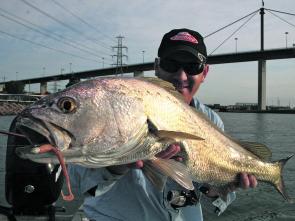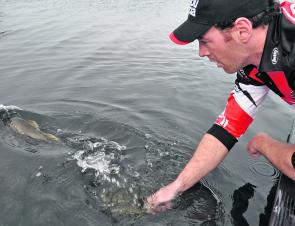Mulloway have been in far greater numbers over the past few years. In fact, since the drought-breaking rains back in late 2010, each of the major systems in and around Melbourne, including the Barwon River just outside Port Phillip Heads as well as the Patterson, Yarra, Maribyrnong and Werribee rivers, have seen an influx of juvenile schoolies ranging in size from, well under the 60cm legal limit, up to about 80-90cm and sometimes beyond.
Interestingly, just two years ago many of the local schoolies encountered were averaging just 40-55cm in length. Twelve months later, anecdotal evidence suggests they had grown to an average size of around 60-65cm, so with any luck, this year we should see a greater percentage of larger specimens, perhaps exceeding the magic metre mark. If you’re up for the challenge, the next few months offer the best chance of tempting one of these silver beasts.
Until recent years, my first-hand knowledge of the mighty and seemingly elusive mulloway was very much limited to a few chance encounters while chasing bream and more stories of the ‘one that got away’ than I care to remember. Last season, however, proved to be a real eye opener with several sessions producing multiple catch and release bags.
Although I’d fluked a few as by-catch over the years, my first specifically targeted mulloway was a real thrill. Nerves, expectation, frustration and patience (or lack thereof at times) each played a role, but once a fairly modest specimen of just 68cm lay cradled in the net beside the boat, feelings of tension and anxiety soon turned to elation and satisfaction.
Every session thereafter, our confidence grew and we began to piece together parts of the puzzle. Chasing mulloway soon became an addictive obsession and I found myself thinking about it day and night for months on end – checking tides, weather forecasts, moon phase calendars and, more importantly, gaps in my work schedule where I could sneak out on the water.
That first capture was the result of eight successive hours of casting for zilch! And then, as if someone had flicked a switch, four school-sized mulloway were caught and released within just half an hour, before the bite again shut down. This example perfectly illustrates the fact that mulloway tend to feed in short, sharp bursts, usually as the current slows during a change in tide. There have been times when we’ve picked them up sporadically throughout the day, although more often than not, it’s a case of three or four hits (or maybe just one) in quick succession and that is all!
In terms of key target areas, bridge pylons, sweeping bends and deeper holes are good places to start searching within any given system. In most instances, however, mulloway are found shadowing larger concentrations of bait, be it yellow-eye mullet, juvenile salmon or whitebait. Interestingly, they also tend to lurk around the outskirts of schooling bream, especially during the cooler months.
While I admire the patience and dedication of successful mulloway specialists who spend endless hours on or beside the water with live baits deployed waiting for a run, my preference is to actively pursue these fish with soft plastics. As far as patterns are concerned, many anglers swear by larger paddle-tails, but I simply can’t go past worm imitations. In particular, the Gulp! Turtle Back variety has accounted for most of our recent success. Rigged on a 1/8-1/6oz jighead, this is a deadly combination in and around Melbourne, whether it’s on the structure laden confines of the metropolitan rivers or more open surrounds such as the lower Barwon estuary.
Most mulloway seem to react to a plastic within the initial stages of the retrieve, either as the lure descends immediately after casting or within the first few hops up off the bottom. Almost always, the lure is intercepted on the drop or as it falls through the water column. Hits are generally quite distinctive and can be recognised by a solid tick or bump that transfers through the rod tip as the lure is eaten. Always try to maintain a slight bow in the line as the plastic descends after casting and in between imparting action.
Anytime the line flicks, twitches or straightens – strike firmly to set the hook. Maintaining contact with the jighead also helps to maximise the hang time and keeps the plastic hovering in front of the fish for longer.
Somewhat surprisingly, tiny metal blades intended for bream also bring many metropolitan mulloway undone.
Perhaps the most important piece of equipment when searching for mulloway is a quality sounder. The example referred to earlier, whereby four mulloway were brought to the net in quick succession after hours of inactivity, only came about because we knew they were in the area after spotting them up on the sounder. This gave us the confidence to keep plugging away and eventually it paid dividends. On most occasions, I won’t start casting until some promising signs in the form of either the target species or large concentrations of bait have at least been located on the sounder.
Reads: 5214
If you’re up for the challenge, the next few months offer Melbourne anglers the best chance of tempting one of these silver beasts.

Since the drought-breaking rains back in late 2010, each of the major systems in and around Melbourne have seen an influx of mulloway ranging in size, from well under the 60cm legal limit, up to about 80-90cm and sometimes beyond.

Tiny metal blades intended for bream also bring many school mulloway undone.

Bridge pylons, sweeping bends and deeper holes are good places to start searching within any given system.

A Gulp! Turtle Back Worm rigged on a 1/6oz jighead is a deadly combination for Melbourne mulloway.

Once you experience some success, chasing mulloway soon becomes an addictive obsession.




